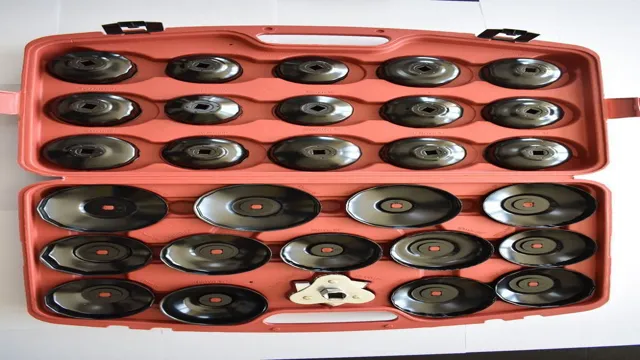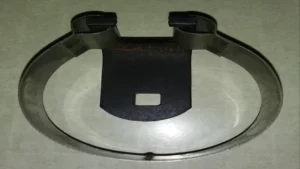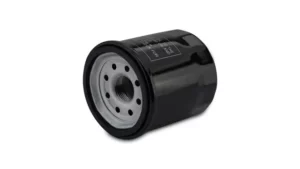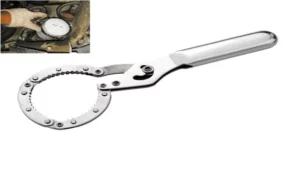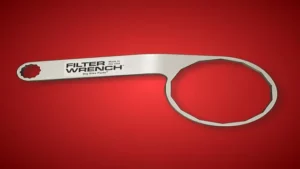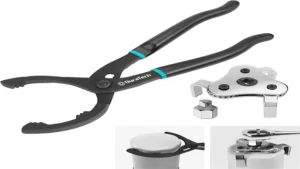Have you ever needed to change your car’s oil filter but realized you don’t have the right size wrench to remove it? It can be frustrating and time-consuming to try different wrenches and still not get the right fit. That’s why knowing how to measure the size of your oil filter wrench is important. An oil filter wrench is a handy tool used to remove the oil filter from a car’s engine.
But with so many different types of oil filters, it can be tricky to find the right size wrench. Determining the correct size of your oil filter wrench can save you time and money, as well as ensure that you have the right tool for the job. There are several ways to measure the size of your oil filter wrench, including using a tape measure or ruler, using a wrench size chart, or consulting your car’s manual.
Each method has its pros and cons, but knowing which one to use can make a big difference in getting the right fit for your oil filter. In this article, we will go over each method in detail and provide you with tips and tricks on how to measure your oil filter wrench size accurately. So, whether you’re a seasoned mechanic or a DIYer, you’ll be able to confidently choose the right oil filter wrench for your car’s needs.
What You Will Need
If you’re wondering how to measure oil filter wrench size, remember that the process is not as complicated as it may seem. The first and most important thing to do is to refer to your owner’s manual to find out what size filter wrench is recommended for your car. Once you have that information, it’s time to measure the filter itself to make sure you’re getting the correct size.
This can be done with a simple tape measure or ruler to find the diameter of the filter. Make sure to measure across the widest part of the filter. Once you have measured the diameter, you can then choose the appropriate size of oil filter wrench.
Having the correct size of wrench is crucial for proper maintenance of your car and making sure your oil filter is working at its best.
– Oil filter wrench
If you’re planning on changing your car’s oil yourself, you’ll need a few essential tools to get started. One tool you’ll definitely need is an oil filter wrench. This specialized wrench is designed to fit onto oil filters to make removing them easier.
They come in a variety of sizes and styles, so make sure you pick one that’s suitable for your vehicle’s filter. When choosing an oil filter wrench, look for one that has a comfortable grip and is made of durable materials. With the right oil filter wrench and a bit of practice, changing your car’s oil will become a breeze.
If you’re not sure which tool is right for your vehicle, consult your owner’s manual or a trusted mechanic for guidance. Don’t forget, using an oil filter wrench is crucial to ensure that your oil filter is replaced properly during your oil change.
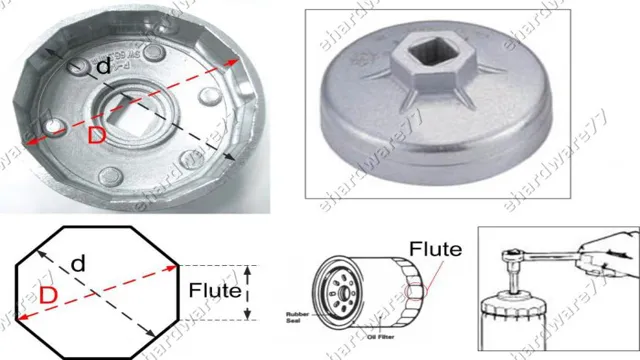
– Ruler or tape measure
When starting a DIY project, having the right tools on hand is essential to ensuring a successful outcome. One tool that you’ll likely need is a ruler or tape measure. These essential measuring tools come in a variety of lengths and styles, so it’s important to choose the right one for your project.
If you’re measuring something small, like a piece of fabric or a picture frame, a small tape measure may be all you need. For larger projects, like building a deck or measuring a room for flooring, a longer tape measure or even a measuring wheel may be necessary. Whichever tool you choose, make sure it’s easy to read and accurate, so you can be confident in your measurements.
With the right measuring tools on hand, you’ll be well-equipped to tackle any DIY project that comes your way.
– Caliper (optional)
If you’re planning to do some DIY work on your car, you may be wondering what tools you’ll need. In addition to the obvious items like a socket wrench set and screwdrivers, you may want to consider adding a caliper to your toolbox. While not strictly necessary, a caliper can be a useful tool, especially if you’re working on the brakes of your car.
A caliper is used to measure the thickness of brake pads and rotors, which can be important when determining whether it’s time to replace them. It can also be used to measure other parts of your car, like the diameter of a bolt or the spacing between two objects. Overall, a caliper can be a handy addition to your toolkit, but it’s not essential for everyone.
If you’re planning on doing more advanced repairs, however, it’s a tool you may want to consider adding.
Method 1: Measure Across the Flats
If you’re wondering how to measure oil filter wrench size, there are a few methods to follow. One common technique is to use the measure across the flats method. This involves finding the distance between two flat edges on opposite sides of the oil filter, and then matching it up with the appropriate wrench size.
To do this, you’ll need a ruler or tape measure to determine the distance between these flats, which should be the widest part of the filter. Once you have this measurement, you can consult your wrench size chart to find the correct tool for the job. Keep in mind that not all filters are created equally, so it’s always a good idea to double-check your measurements and compare them with any additional information provided by the manufacturer or in your vehicle’s manual.
– Place the wrench on a flat surface
When it comes to measuring wrenches, one of the most common methods is to measure across the flats. To do this, you need to place the wrench on a flat surface, making sure it is not twisted or turned in any way. From there, you can measure the distance between the two opposite flat sides of the wrench using a caliper or measuring tape.
This measurement will give you the wrench size, which is typically listed in both inches and millimeters. It’s important to note that the size of the wrench is determined by the distance between the opposite flat sides, not the distance between the points of the wrench. By using this method, you can ensure that you choose the correct size wrench for any job, whether you’re working on a car, a piece of machinery, or any other project that requires the use of a wrench.
– Measure the distance across the flats
When it comes to measuring the distance across the flats, there are a few methods you can use. The first method is to measure across the widest part of the hexagon, from one flat edge to the opposite one. This is known as measuring across the flats or measuring the “flat-to-flat distance.
” To do this, you’ll need a measuring tool, such as a caliper or ruler. Simply place the tool’s jaws or edge across the flats of the hexagon and note the measurement. It’s important to ensure that the measurement is taken from opposite flat faces, as measuring from adjacent faces will give you an incorrect measurement.
Measuring across the flats is a common method used in engineering, construction, and manufacturing industries when dealing with hexagonal shapes. By using this method, you can ensure the accuracy and precision of your measurements for a wide range of applications.
– Round up to the nearest quarter inch
If you need to measure something round, like a pipe or hose, one method is to measure across the flats. This means you measure the distance from one flat side to the other flat side, not the curved length. To get the most accurate measurement, use a caliper or ruler that has quarter-inch increments.
Round up to the nearest quarter inch to get the final measurement. For example, if you measure across the flats and get 9 inches, round up to 3 inches.
This will ensure that you have an accurate measurement without any guesswork. By using this method, you can be confident that your measurements will be precise and lead to successful projects.
Method 2: Measure the Circumference
If you’re wondering how to measure oil filter wrench size, one method that works well is to measure the circumference of the filter. To begin, you’ll need a flexible tape measure or string and a ruler. Wrap the tape measure or string around the widest point of the filter and mark where the ends meet.
Then, use the ruler to measure the distance between the two markings. This measurement will give you the circumference of the filter. Once you have this measurement, you can refer to a chart or consult your owner’s manual to find the corresponding wrench size.
Keep in mind that it’s important to use the right size wrench to avoid damaging the filter or creating leaks. With this method, you’ll be able to easily determine the correct size oil filter wrench for your vehicle.
– Wrap a string around the widest part of the filter
When it comes to measuring the circumference of your filter, there are a few methods you can use to ensure accuracy. One such method is wrapping a string around the widest part of the filter. This will allow you to get an exact measurement of the circumference, which you can then use to purchase the right size replacement filter.
To do this, simply take a piece of string and wrap it around the widest part of the filter. Take note of where the two ends of the string meet and then use a ruler to measure the length of the string. This measurement is your filter’s circumference.
Keep in mind that this method works best for cylindrical filters and may not be suitable for filters with irregular shapes. By using this method, you can rest assured that you are getting the right size replacement filter for your air or water filtration system.
– Measure the length of the string
If you want to measure the length of a string but don’t have a ruler or measuring tape handy, there’s another method you can use: measuring the circumference. To do this, simply wrap the string around a circular object such as a pen or pencil, making sure the string is taut all the way around. Mark the point where the end of the string overlaps the rest of the string, then lay the string flat and measure the distance between the mark and the end of the string.
This measurement will be the circumference of the object the string was wrapped around. To find the length of the string itself, you’ll need to divide the circumference by 2π, which is approximately 1
This will give you the length of the string in units of the radius of the object the string was wrapped around. This method can be especially useful if you’re working with a string that’s too long to measure easily with a ruler, or if you don’t have a ruler or measuring tape on hand. So next time you need to measure the length of a string, don’t despair if you don’t have a ruler – just grab something circular and start measuring!
– Divide the length by 3.14 to get the diameter
When it comes to measuring the diameter of a circle, there are two main methods: measuring the radius or measuring the circumference. Method 2 involves measuring the circumference, which can often be more accurate if the circle is not perfectly round. To use this method, you need to take a string or flexible measuring tape and wrap it around the widest part of the circle, making sure it is snug but not too tight.
Once you have the circumference measurement, divide it by 14 (or pi) to get the diameter. It’s important to note that pi is an irrational number, which means it goes on infinitely without repeating.
This is why using a calculator or rounded value can lead to slight inaccuracies. By dividing the precise circumference measurement by pi, you can ensure a more accurate diameter measurement for your circle.
Method 3: Use a Caliper
If you want to know how to measure oil filter wrench size, using a caliper is another option. A caliper is a precise measuring tool that can accurately measure the diameter of your oil filter. First, you need to select the appropriate jaws or ends of the caliper that will fit around the oil filter.
Then, gently place the jaws on opposite sides of the filter’s diameter and adjust the caliper until it’s snug. Finally, carefully remove the caliper and read the measurement from the display. Keep in mind that calipers are precise measuring tools that can give you an accurate reading, but they can be expensive and take some practice to use effectively.
However, if you need an exact measurement of your oil filter wrench size, using a caliper is a good option. Overall, regardless of which method you choose to measure your oil filter wrench size, the important thing is to make sure you have the correct size wrench for your oil filter to avoid any complications during oil changes.
– Place the caliper across the flats of the wrench
When it comes to tightening or loosening a wrench, precision is key. If you want to make sure that your wrenches are tightened to the right specifications without damaging the fastener, using a caliper is a great option. The process is simple – you just need to place the caliper across the flats of the wrench to measure its width accurately.
This will give you a clear idea of the exact size of the wrench and help you determine the amount of torque required. Remember to use the caliper at the exact midpoint of the wrench to get the best results. Using a caliper is an excellent way to get the desired torque without damaging the fastener or under-torqueing, which can lead to loosening of the wrench over time.
By using precise measurements with a caliper, you can ensure that your wrenches are tightened correctly every time, making them last longer and perform better. Next time you need to tighten a wrench, consider using a caliper for a more accurate and precise result.
– Take the measurement
When it comes to taking accurate measurements, using a caliper is a great method that can give you precise and reliable results. Calipers are tools that can measure the distance between two opposite sides of an object, and they’re commonly used in various industries, including engineering and manufacturing. To use a caliper, start by opening the jaws and placing them on either side of the object you want to measure.
Gently close the jaws until they come into contact with both sides of the object, then read the measurement indicated on the scale. This method is especially useful for measuring non-cylindrical objects like jewelry, coins, and even body fat. By using a caliper, you can ensure that your measurements are accurate and consistent, allowing you to make informed decisions about the objects you’re measuring.
So next time you need to take precise measurements, consider using a caliper for accurate results.
Conclusion
In conclusion, measuring the size of an oil filter wrench can be a bit of a guessing game. However, with a few simple steps, you can determine the right size in no time. So, grab your trusty ruler or tape measure, take note of the filter’s diameter, and use a bit of trial and error to find the perfect fit.
Remember, just like with any tool, it’s important to use the right size to avoid any unnecessary frustration or damage. Happy wrenching!”
FAQs
What is an oil filter wrench and why do I need one?
An oil filter wrench is a tool used to remove oil filters from vehicles or machines. You need one to make the removal process easier and to ensure a tight grip on the filter during removal.
How do I determine the size of the oil filter wrench I need?
You can determine the size of the oil filter wrench you need by measuring the diameter of the filter itself and matching it to the appropriate wrench size.
Can I use a regular wrench to remove an oil filter?
No, using a regular wrench to remove an oil filter can cause damage to the filter and make it harder to remove. An oil filter wrench has a specialized design to grip the filter properly.
What if I can’t find an oil filter wrench in the correct size?
You can try using a strap wrench, which can adjust to fit different sizes of filters. Alternatively, you can try using pliers or vice grips, but be careful not to damage the filter or surrounding parts.
Should I use a torque wrench when replacing the oil filter?
No, a torque wrench is not necessary when replacing the oil filter. Just make sure to tighten the filter snugly by hand, but not so tight that you can’t remove it next time.
How often should I replace my oil filter?
It is recommended to replace your oil filter every time you change your oil, which is typically every 3,000 to 5,000 miles.
What happens if I don’t replace my oil filter regularly?
If you don’t regularly replace your oil filter, it can become clogged with debris and prevent oil from flowing through the engine properly. This can lead to engine damage and expensive repair bills.
